The 2025 FanGraphs Fan Exchange Program: Summary and Conclusions
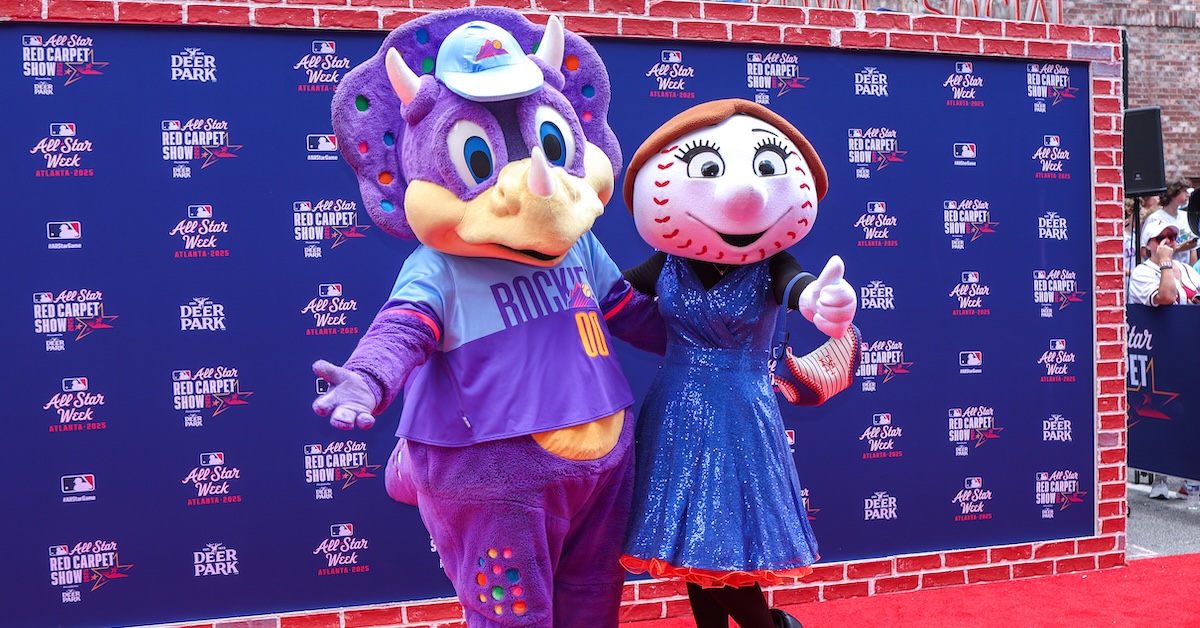
You might remember that, back in May, I issued a challenge to baseball fans across the globe: Give up your favorite team for a week and follow another. Thus was the inaugural FanGraphs Fan Exchange Program born.
I published the original survey on May 20, assigned everyone a new team to watch between June 16 and June 23, and promised to publish my findings sometime in mid-July. July, as you might have noticed, has come and gone, and so has most of August, but the results are finally in.
Why the delay? Well, I want to say that draft season bled into trade deadline season and I just couldn’t find the time, but that’s not the whole story. I didn’t consider that I would have to do more to publicize the exit survey than post a link on BlueSky, and quite a bit of time passed before I went back to the original email list and sent a link directly. If you’re still waiting for the exit survey as you’re reading this, well, I’m quite embarrassed to say that doesn’t surprise me. At the end of the day, I’m not sure it went out to everyone.
Nonetheless, I’ll put my cards on the table here: Part of the reason I slacked off with the exit survey is that it was the third-most interesting component of this project to me. First was just creating a shared experience for somewhere around 1,000 of you who decided to participate. The baseball season is long and frequently monotonous, so a break in routine can be healthy.
Moreover, the data I was most interested in, by a huge margin, came from the entrance survey. I wanted to know what you guys thought about your favorite teams; whether spending a week on Wife Swap with the Cardinals or White Sox was a wake-up call or not… well, that’s between you and your conscience.
All told, I got 1,275 responses to the entrance survey and was pleased to see that while the sample varied wildly from team to team (Cubs fans outnumbered Marlins fans in the final accounting by a ratio of 26-to-1), at least four self-professed fans of all 30 teams participated. Twenty-three teams sent at least 20 fans. Not enough to draw conclusions in all or even most cases, but enough to be interesting.
The entrance survey comprised 42 questions in seven sections: First, I asked respondents to rank their club on the 20-80 scale in broad terms. Is your major league roster any good? Is the team fun to watch? Is the front office composed of geniuses or dumdums? Then I used the same scale to ask more detailed questions about the performance of each team’s field manager, position player group, pitching staff, and TV broadcast.
You know, the important stuff.
I won’t bore you with a blow-by-blow of all 30 teams’ responses. Instead, here’s a summary of the number of fans from each team who participated, and the best and worst thing about each team, according to the fans’ average grades in every category:
| Team | Responses | Best Category | Mean Grade | Worst Category | Mean Grade |
|---|---|---|---|---|---|
| ARI | 8 | Entertainment factor | 70 | Ownership | 36 |
| ATH | 11 | Hitting for power | 54 | Ownership | 25 |
| ATL | 49 | Front office | 64 | Bullpen management | 43 |
| BAL | 62 | TV broadcast humor/banter | 70 | Clutch hitting | 29 |
| BOS | 79 | TV broadcast sideline reporter | 58 | Clutch hitting | 42 |
| CHC | 104 | Baserunning | 70 | High-leverage RP | 42 |
| CIN | 21 | Mgr clubhouse management | 61 | Ownership | 26 |
| CLE | 49 | Front office | 65 | SP going deep into games | 41 |
| COL | 17 | TV broadcast sideline reporter | 54 | Front office | 22 |
| CWS | 31 | TV broadcast studio show | 56 | Ownership | 25 |
| DET | 51 | TV broadcast play-by-play | 77 | Ownership | 50 |
| HOU | 28 | TV broadcast sideline reporter | 68 | Baserunning | 46 |
| KCR | 19 | Defense | 61 | Hitting for power | 33 |
| LAA | 23 | TV broadcast play-by-play | 63 | Ownership | 23 |
| LAD | 66 | Major league roster | 74 | SP going deep into games | 38 |
| MIA | 4 | TV broadcast play-by-play | 56 | Ownership | 23 |
| MIL | 30 | TV broadcast sideline reporter | 66 | Hitting for power | 35 |
| MIN | 38 | Mgr relationship with public | 61 | Ownership | 34 |
| NYM | 84 | TV broadcast overall | 79 | SP going deep into games | 47 |
| NYY | 83 | Hitting for power | 73 | Baserunning | 45 |
| PHI | 95 | SP going deep into games | 70 | Defense | 45 |
| PIT | 24 | Pitcher command | 55 | Ownership | 20 |
| SDP | 28 | TV broadcast overall | 77 | Hitting for power | 49 |
| SEA | 86 | Pitcher command | 65 | Ownership | 37 |
| SFG | 37 | TV broadcast overall | 75 | Hitting for power | 42 |
| STL | 31 | Defense | 62 | Pitchers getting whiffs | 39 |
| TBR | 18 | Front office | 69 | Ownership | 32 |
| TEX | 18 | Mgr clubhouse management | 68 | Situational hitting | 37 |
| TOR | 44 | Defense | 69 | Hitting for power | 40 |
| WSN | 37 | TV broadcast play-by-play | 50 | High-leverage RP | 34 |
If there was a shocking result from the first few sections of the survey, it’s this: I was shocked by how little these results surprised me. Sometimes, that was for on-the-field reasons; yes, the Yankees are great at hitting for power and pretty poor at running the bases, for instance.
But also, you guys seem to absolutely love your TV broadcast teams. No fewer than 13 fan bases ranked some aspect of the TV broadcast as the best thing about the team, and across the entire league, the highest-scoring category was overall TV broadcast, with a mean of 62 and a modal answer of 80. Well deserved, in my opinion. I think we’re in something of a golden age for local TV broadcasts; when I started writing about baseball in the early 2010s, I had a list of teams whose home broadcasts I would avoid under all circumstances. Now, when I flip to a new game on MLB.TV and hear the announcer’s voice, my reaction for almost half the league is, “Yay, I love these guys!” (And, increasingly, gals.)
On the other end, only nine categories got a median response of 20, the lowest grade possible. I wonder what they have in common:
| Team | Category | Median | Mean |
|---|---|---|---|
| Pirates | Ownership | 20 | 20.42 |
| Rockies | Front office | 20 | 21.76 |
| Rockies | Ownership | 20 | 22.35 |
| Marlins | Ownership | 20 | 22.50 |
| Angels | Ownership | 20 | 23.26 |
| White Sox | Ownership | 20 | 24.52 |
| Athletics | Ownership | 20 | 25.45 |
| Pirates | Hitting for average | 20 | 26.04 |
| Pirates | Vibes and intangibles | 20 | 30.21 |
I will say that in general, fans are pretty neutral about their teams’ owners. Some actually have positive feelings, though, like Dodgers fans, who gave their owners a median grade of 80 and a mean grade of 73.94. And as much as I like to seize on any excuse to rag on billionaires, the Dodgers’ owners spend gobs of money to construct a team that signs big-name free agents, makes the playoffs every year, and has won two of the past five World Series. They write the checks and let a smart front office cook; I’m really not sure what else you can ask for under this economic model.
Most fan bases graded their owners between 35 and 60, but some fan bases have just had it with the guy on the masthead. And just as the Dodgers’ owners have earned their praise, the people represented on this chart have earned every bit of the derision they’re getting.
It is nice to have some indication of which fans hate their owners most: 24 Pirates fans responded, and 23 of them gave Bob Nutting a grade of 20. The lone voice of moderation chipped in a 30, which might’ve been a mistake. To be honest, a median answer of 20 on vibes is even sadder. It got me curious about where every team’s vibes were around Memorial Day:
| Team | Median | Mean |
|---|---|---|
| ARI | 60 | 59.38 |
| ATH | 40 | 41.82 |
| ATL | 55 | 56.02 |
| BAL | 40 | 42.26 |
| BOS | 55 | 55.38 |
| CHC | 70 | 67.99 |
| CIN | 55 | 53.81 |
| CLE | 60 | 57.65 |
| COL | 45 | 42.65 |
| CWS | 40 | 38.55 |
| DET | 70 | 71.47 |
| HOU | 55 | 58.75 |
| KCR | 60 | 59.47 |
| LAA | 40 | 43.04 |
| LAD | 70 | 66.14 |
| MIA | 65 | 55.00 |
| MIL | 55 | 55.00 |
| MIN | 55 | 52.98 |
| NYM | 60 | 62.44 |
| NYY | 60 | 62.47 |
| PHI | 70 | 64.68 |
| PIT | 20 | 30.21 |
| SDP | 70 | 71.61 |
| SEA | 60 | 60.58 |
| SFG | 60 | 60.41 |
| STL | 55 | 53.49 |
| TBR | 55 | 56.67 |
| TEX | 50 | 51.39 |
| TOR | 55 | 52.73 |
| WSN | 45 | 45.27 |
If I ran MLB Network or ESPN, I’d find 1,000 fans of every team in baseball and give them a vibes dial that they could turn up or down on a daily basis, like a live focus group. Then I’d publish the vibes graph alongside (or, perhaps, instead of) the standings page.
The next section invited fans to evaluate certain statements about their team’s fortunes. I was interested in two broad questions: What are the expectations for your favorite team? And do you think your team gets fair treatment from neutral entities? I’ll just publish the results in full, starting with your expectations:
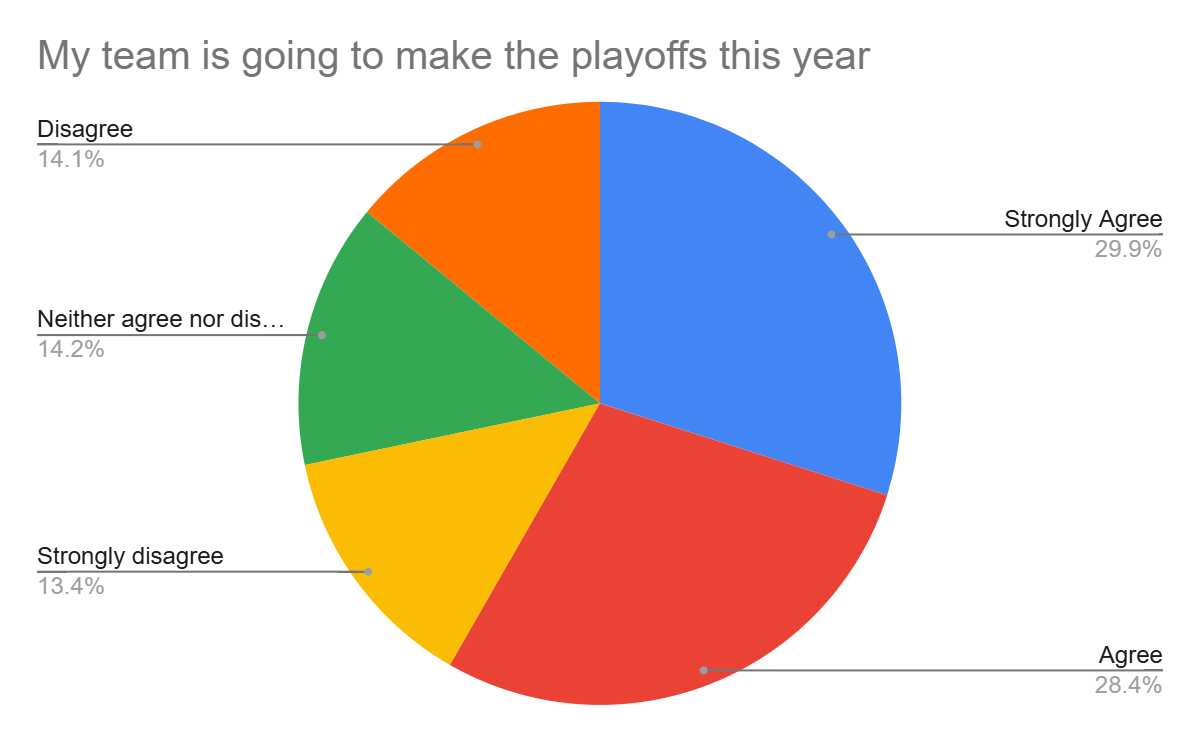
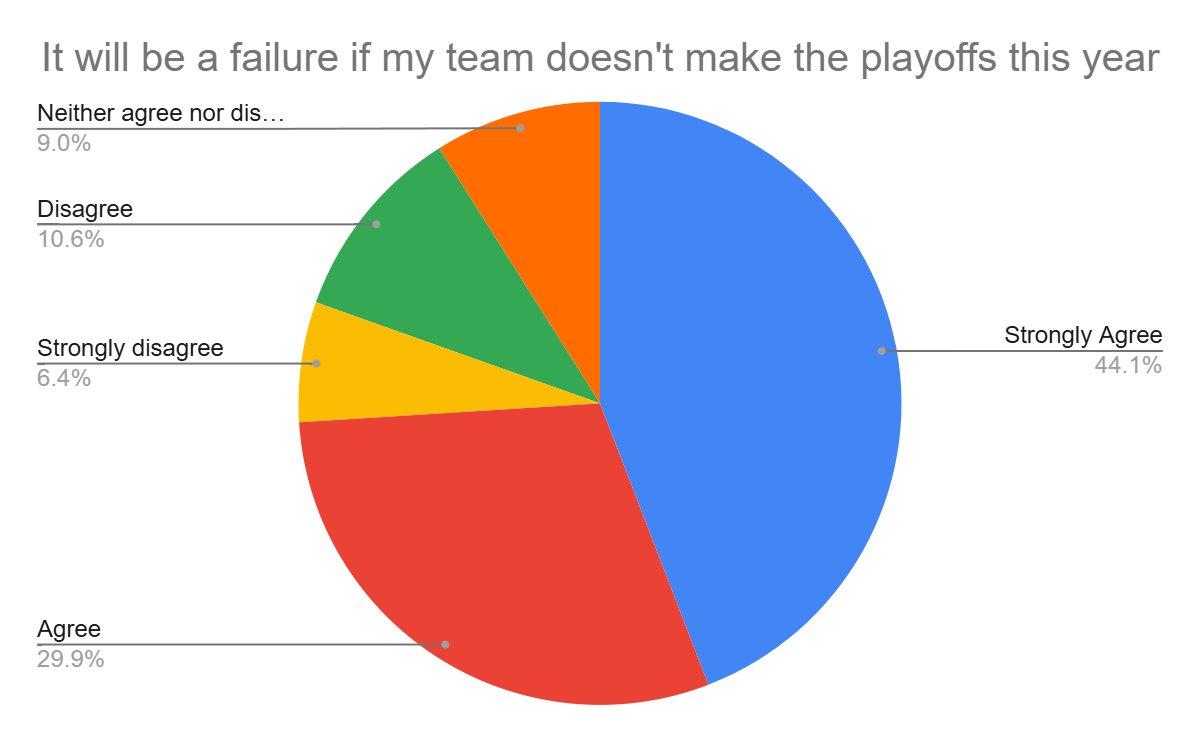
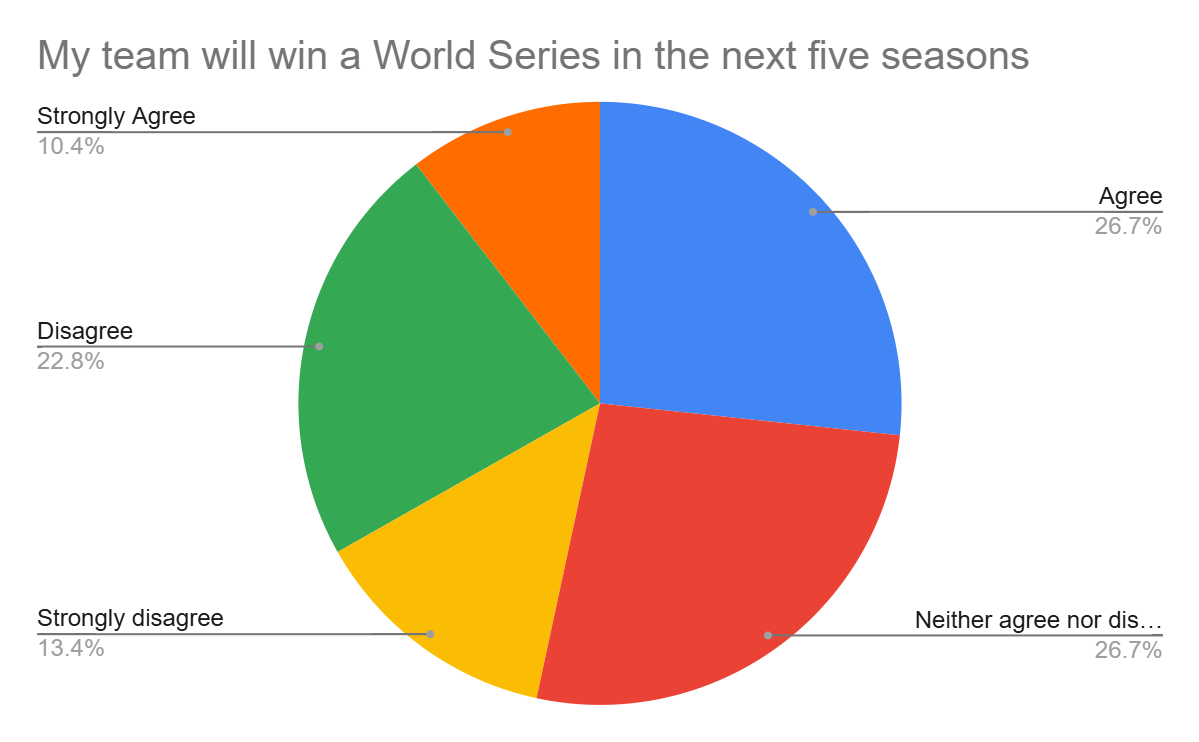
Sure seems like everyone’s a little optimistic here. More than a third of respondents either agree or strongly agree that their team will win a championship in the next five seasons? You do know that only one team gets to win the World Series every year, right?
Two caveats here: First, remember that most of these answers came in during late May and early June, and a lot has happened since then. Squint at these numbers long enough and you can see a picture of a Tigers fan skipping through a sun-soaked field of wildflowers, not a care in the world.
Second, those dastardly big-market teams have lots of fans, and therefore made up an outsize percentage of the response pool. Almost half of the responses came from fans of the following seven teams: the Cubs, the Phillies, the Mariners, the Mets, the Yankees, the Red Sox, and the Dodgers. That’s six clubs with massive payrolls, massive historical pressure to win, or both. Plus the Mariners, whose fans are apparently allergic to logging off.
The second subsection involved questions about luck and fairness, and to be honest, I was rubbing my hands together wishing for an overwhelming, cross-team consensus that the umpires and the media are all biased, and my team has bad injury and prospect luck, and woe is us. Let’s see if that’s the case:
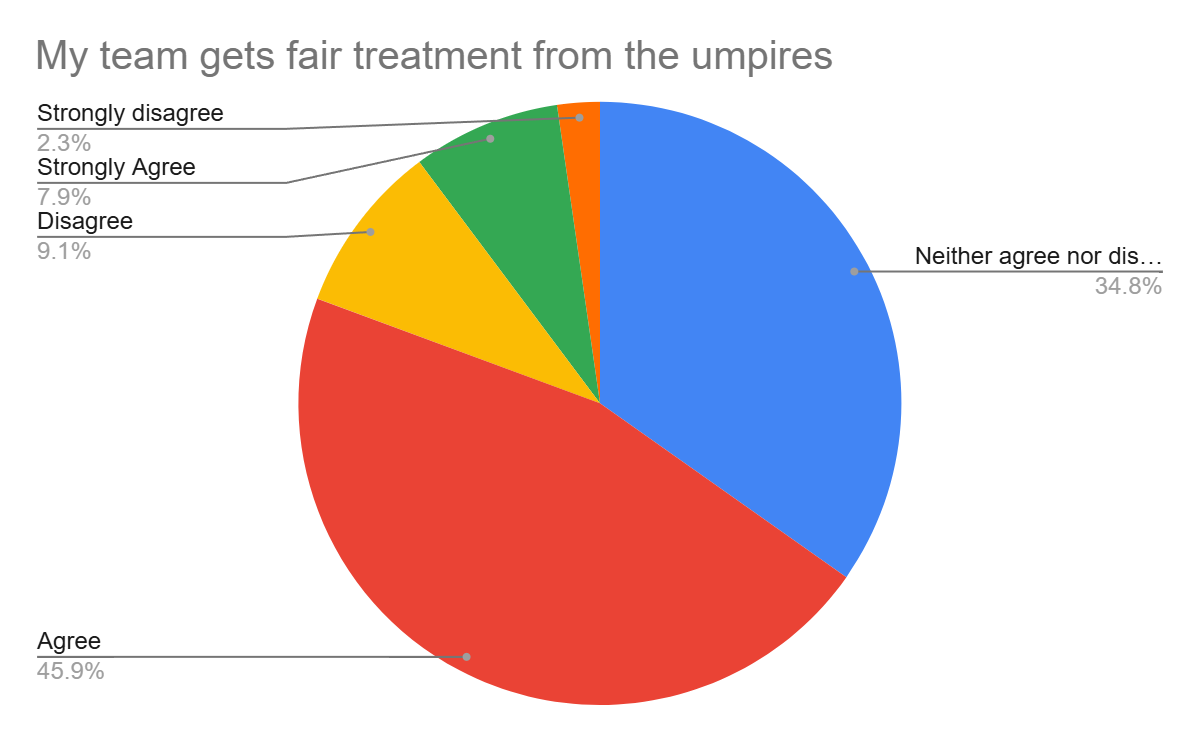
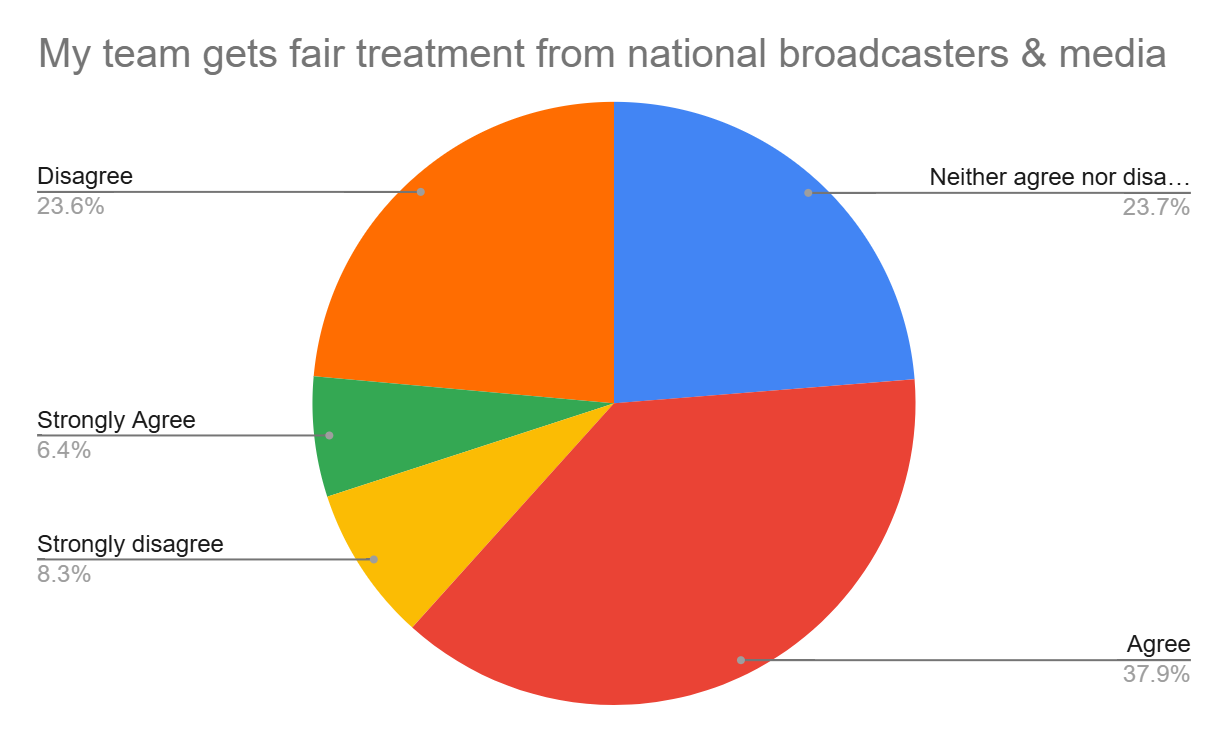
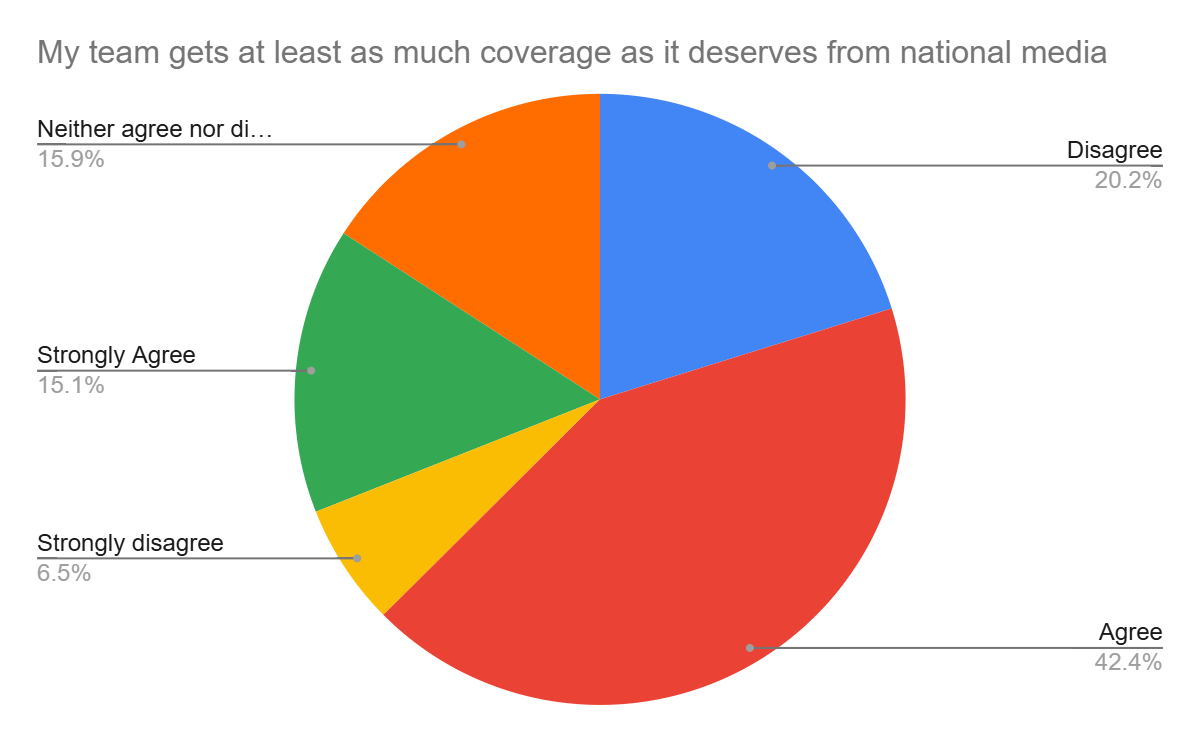
Probably some more big-market response bias here, but in general, it does seem like everyone’s realized that certain dyspeptic national commentators hate your team because they hate everyone.

Come on, this is downright measured and rational!
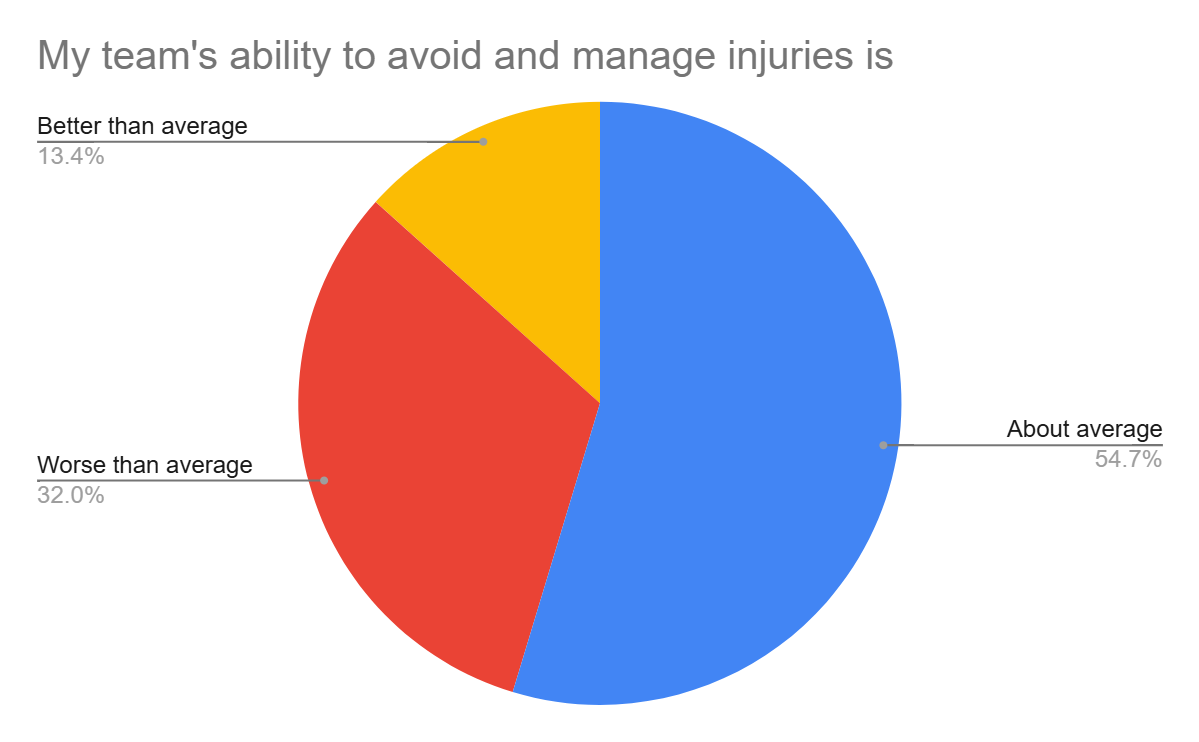
A little more self-pitying, but even Mets fans were pretty level-headed about this question; only 14.3% of them said their team was worse than average on the injury front. This compared to 57.1% of Astros fans, who might be paranoid but that doesn’t mean they’re wrong.
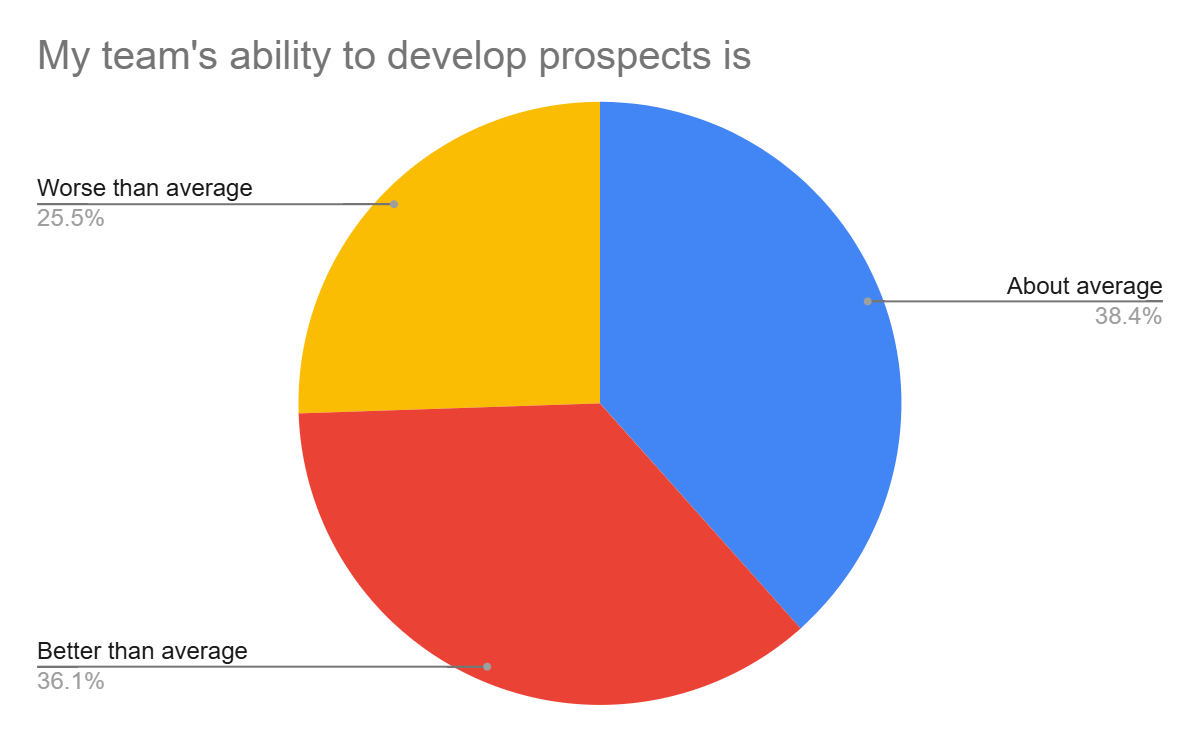
You guys are more optimistic about your team’s prospects, resulting in a pie chart that, if you rotated it about 60 degrees counterclockwise, would look a little like the flag of the Philippines.
The final segment of the entrance survey asked respondents to identify who they thought was their team’s best player, and to name both their favorite and least favorite player on the roster:
The two players who got unanimous approval as the best on their team were Aaron Judge and José Ramírez, and their selections were illuminating in a couple respects. First, I might’ve expected more unanimous selections among teams with lower response rates, but one out of eight Diamondbacks fans picked Ketel Marte over Carroll and one out of 24 Pirates fans chose Bryan Reynolds over Skenes.
But both the Yankees (83 responses) and the Guardians (49 responses) were very well-represented in the survey, and yet there was an obvious choice in both cases. So obvious, in fact, that more than a few Yankees fans said Judge was the best player on the team, but in a sarcastic way.
Which brings up another point: the “no consensus” answers in this table, mostly in the Least Favorite Player category. A non-trivial percentage of respondents refused to answer this question on the grounds that it was unkind, and in that spirit I only listed a “winner” if one clear vote-getter emerged above the others. I didn’t want to make it sound like one guy was a pariah when he got four votes in a poll of 20 people.
In a resounding victory for regional stereotypes, half of the 10 teams with a “no consensus” outcome play either in the Midwest or Canada, while baseball fans from the East Coast seemed to have little trouble coalescing around disliking a specific guy.
So we know what everyone thought heading into the experiment. Let’s see what following a different team for a week did to everyone’s perceptions.
I got 308 responses to the exit survey; even if I’d been even remotely systematic about distributing it, I would’ve expected a significant drop-off. Remembering to fill out a form weeks later is pretty scattershot. I also got several emails and social media messages within the first 48 hours of Exchange Week, the substance of which could be summarized as: “I can’t bear to watch another inning of White Sox baseball, you bastard, I quit!”
Which is fair enough.
I considered going category-by-category, but I’ll just say that in general, respondents preferred most aspects of their favorite team to their exchange team. Here’s a typical breakdown:
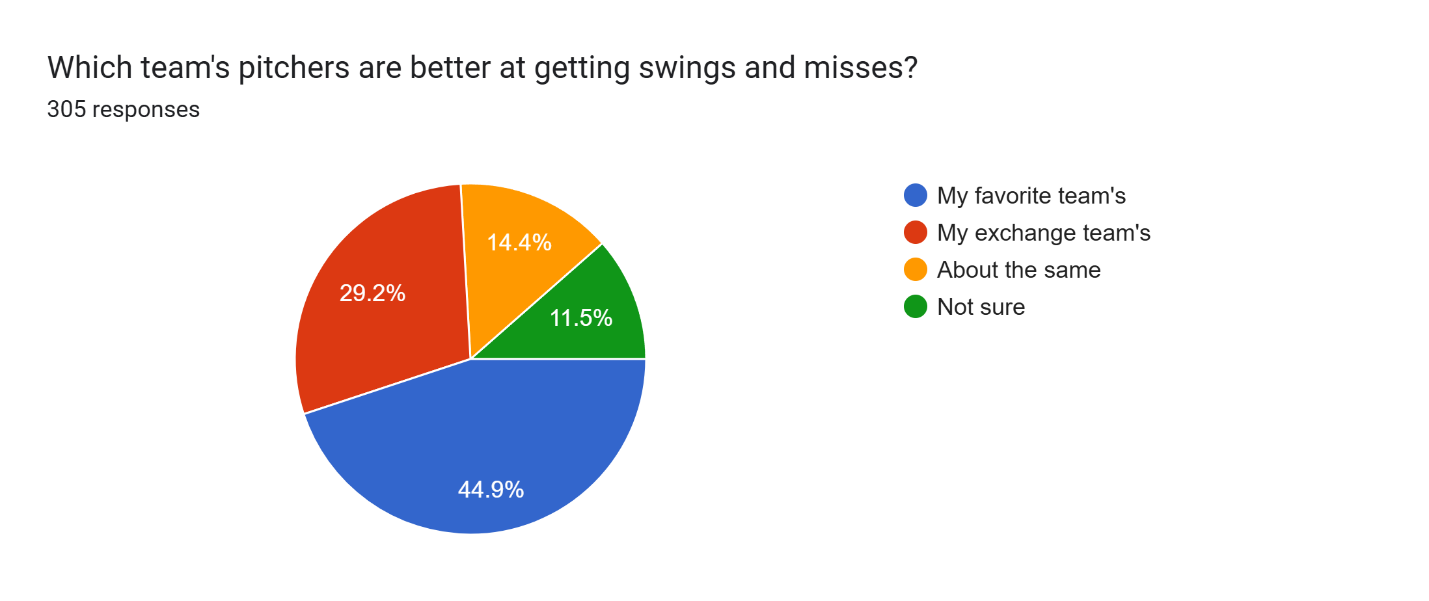
A little less than half say their team is better, a little more than a quarter say their exchange team is better, with the rest split about evenly between “about the same” and “not sure.”
One question, and one question only, got more people to say they preferred their exchange team to their favorite team:
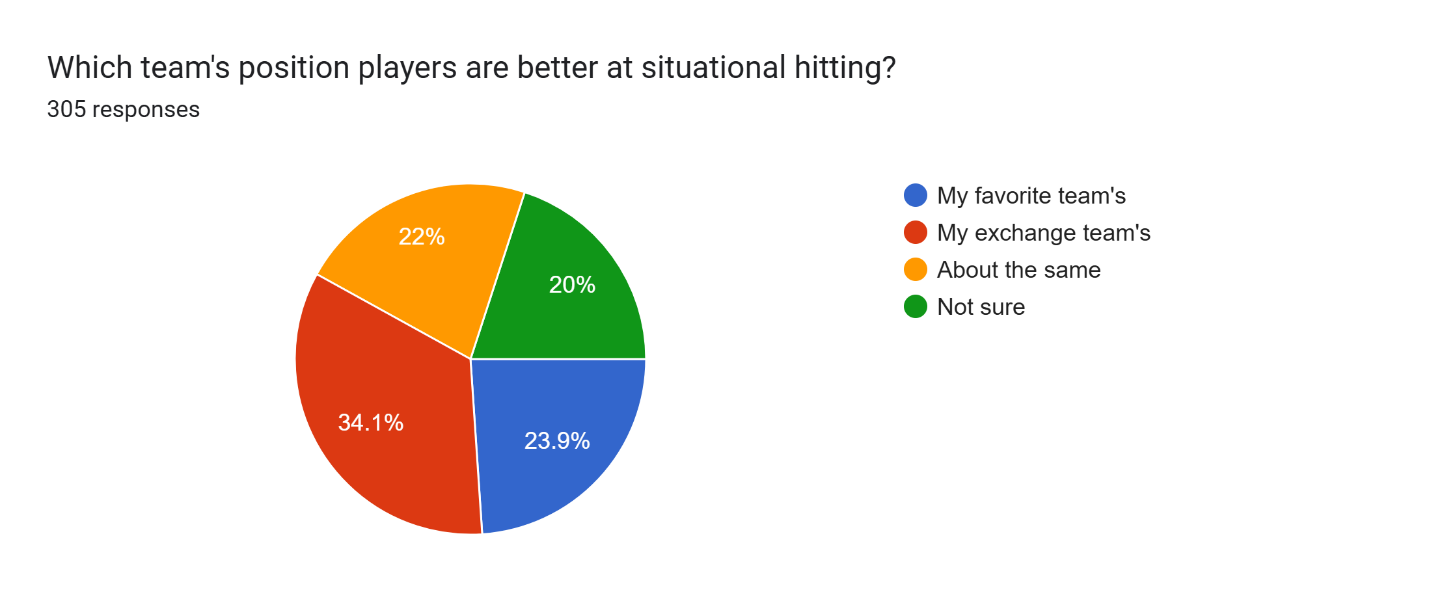
This is the one hypothesis I had going into the experiment that was borne out in the data: Everyone thinks their team strikes out and grounds into double plays all the time. Better the devil you know… except when it comes to situational hitting. Surely the devil you don’t know can move a runner over.
Now for the big finale: How, if at all, did the Exchange Program change how fans viewed their favorite teams?
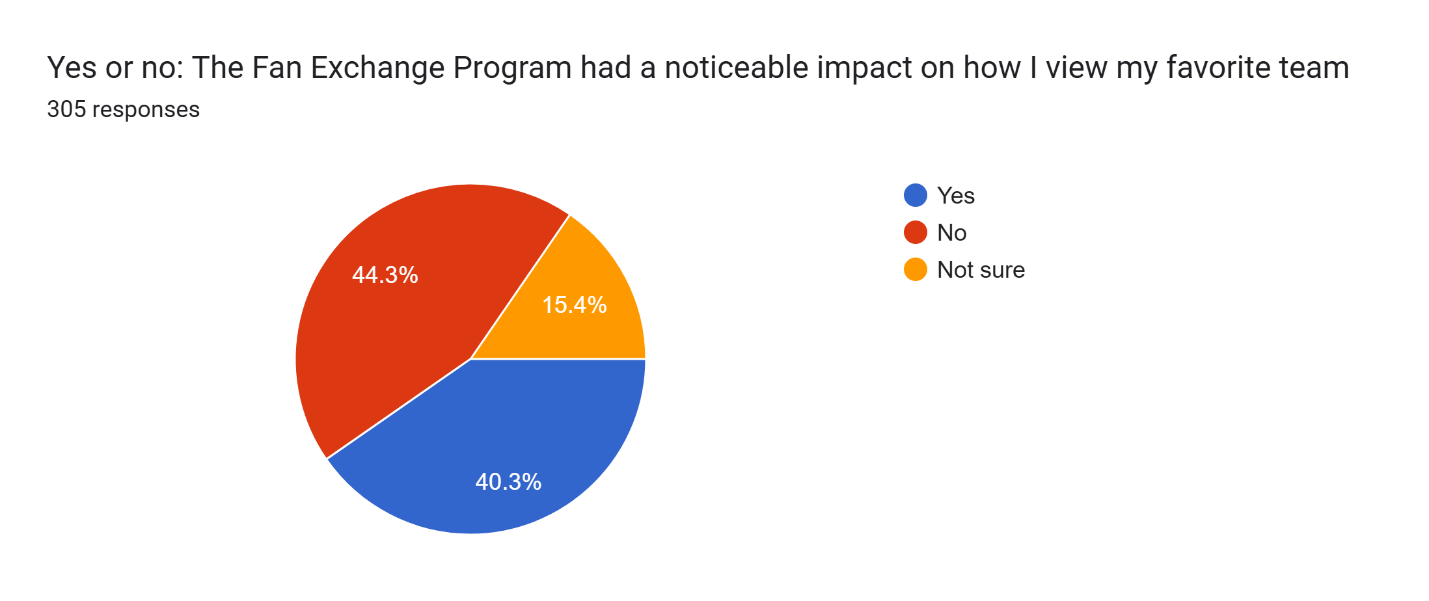
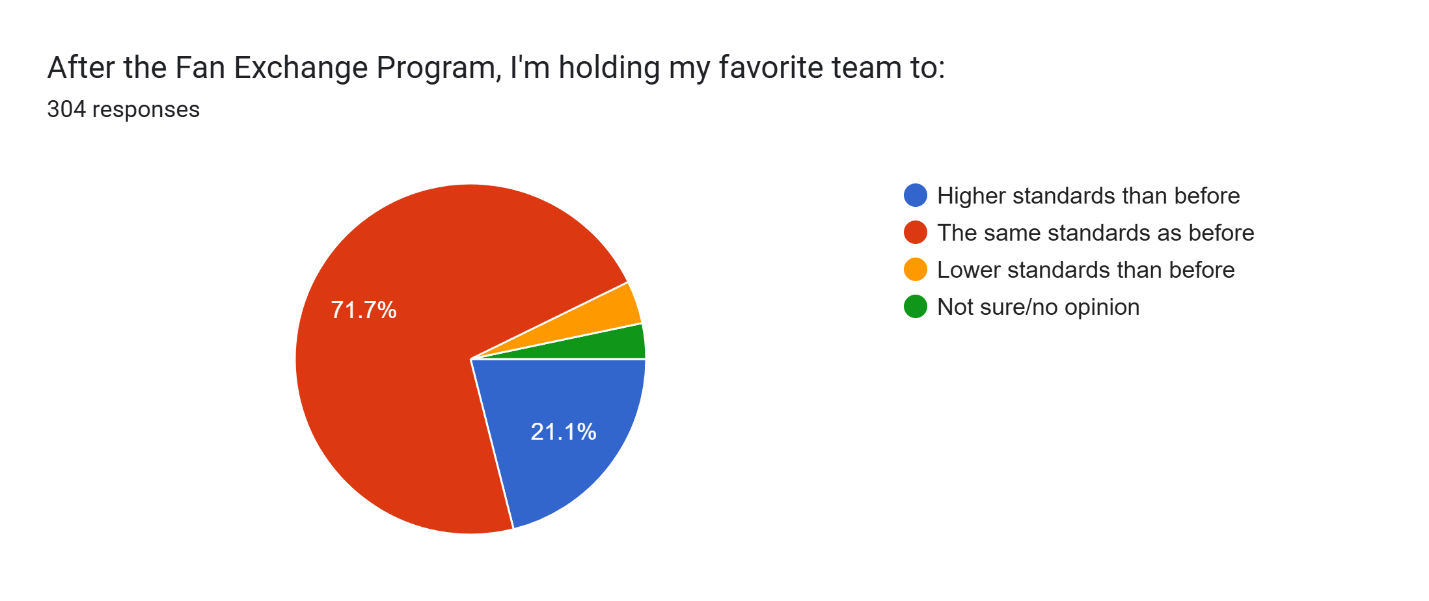
Among those who said the experience had changed their opinion of their favorite team, the plurality (26%) said their opinion of their team’s broadcast changed the most. I left an open-ended question to this effect near the end of the survey: “My most striking or interesting takeaway from the Fan Exchange Program was:” and many of the answers there backed up that sentiment. As much as everyone loves their hometown announcers, the Tigers’ and Cubs’ TV crews got conspicuously good feedback from their exchange fans.
One Phillies-to-Twins convert wrote a delightfully incisive summary of how there’s more than one way to call a baseball game: “How much the Twins rely on Audra Martin (sideline reporter) and her story telling with the players in the clubhouse/off the field, while the Phillies just talk ball and let Kruk say weird shit.”
I guess it’s not earthshaking news that broadcast presentation has a massive impact on the baseball-watching experience. I’ve written in the past about how a baseball broadcaster who’s in your home five or six nights a week becomes a de facto part of the family. Even so, I was still surprised by how much of the open-ended feedback to the survey concerned the broadcast, rather than the teams involved.
Likewise the extent to which baseball fans, even fans with universal enough tastes to read FanGraphs and participate in a survey like this, are often one-club fans. The exchange program did broaden many people’s horizons, but not by much; 70.1% of exit survey respondents said they would watch their exchange team “from time to time,” or that they were “more interested in this team than before, but only by a trivial amount.” (Apologies to the 4.9% of respondents who said “This week was a living hell; you couldn’t pay me to watch this team again.”)
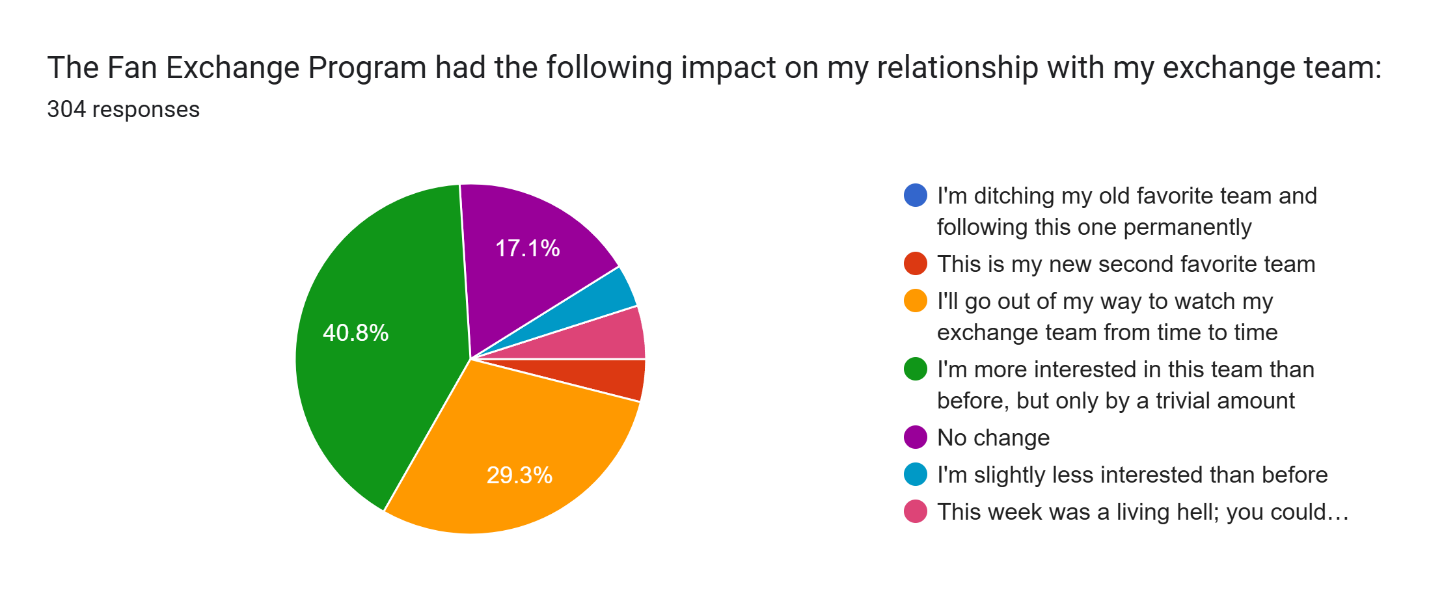
I’ll cherry-pick two representative open-ended responses here:
I love my favourite team. There’s such a high level of comfort watching their games. I felt I was actively doing “work” while watching my exchange team.
I really enjoyed watching my exchange team, but at the end of the day, I just want to watch my favorite team. I guess this confirmed my true fandom.
I’ll put my hands up; the genesis of this project was my frustration with baseball fans’ provincialism, a refusal to see the whole league. In reality, many fans have a relationship with a single team, but not the entire league. And while everyone could stand to learn a little more about the world around them, I shouldn’t look down my nose at people who care little about the other 29 teams in the league. (Not least because this is precisely how I follow the NFL at this point.)
As much as the day-to-day practice of baseball seems to be about cherishing the familiar, I want to end by highlighting the new friends we made along the way. In the exit survey, I included the questions from before about the best and favorite players on the team. But I also added a couple new categories: “I was unfamiliar with this player before the Fan Exchange Program, but he made a positive impression” and “This player did the most to change my preconceptions about him.”
Plenty of people answered “none” to one or both, either because they were sick of survey questions or because they already know everything. But the following players showed up at least three times in the responses to one of those two questions:
| New Players | Changed Preconceptions |
|---|---|
| Addison Barger | Byron Buxton |
| Casey Schmitt | CJ Abrams |
| CJ Abrams | Jesús Sánchez |
| Dane Myers | Kyle Stowers |
| Heliot Ramos | Logan O’Hoppe |
| Jac Caglianone | Luis Robert Jr. |
| Noah Cameron | Matthew Boyd |
| Otto Lopez | Pete Crow-Armstrong |
| Otto Kemp | Seth Lugo |
| Yohel Pozo | |
| Zach Neto |
I originally pitched this experiment as a study abroad program you can do without leaving your couch, and I hope that those of you who have had your eyes opened to the wonders of Kyle Stowers or CJ Abrams will hold those fond memories dear forever.
Thanks to everyone who participated, and I hope to see you back in the program next season.
Michael is a writer at FanGraphs. Previously, he was a staff writer at The Ringer and D1Baseball, and his work has appeared at Grantland, Baseball Prospectus, The Atlantic, ESPN.com, and various ill-remembered Phillies blogs. Follow him on Twitter, if you must, @MichaelBaumann.
This was so much fun – I’m looking forward to next season! It was very funny to be an exchange fan of the Marlins right when they got good for about a month – I kept following along for a few weeks just because the vibes were high. (Then they came back to earth and I admit I hopped off the bandwagon)
I would also humbly recommend for next year’s surveys to include rating the radio broadcast as well as the TV broadcast! I know radio is mostly for the sickos these days but at times I have felt very differently about the Sox’ radio vs. TV teams.
This is such a good idea!!! Doesn’t MLB TV give fans the option to turn on the radio audio too?
Yup. It’s a godsend when the games are on Fox.